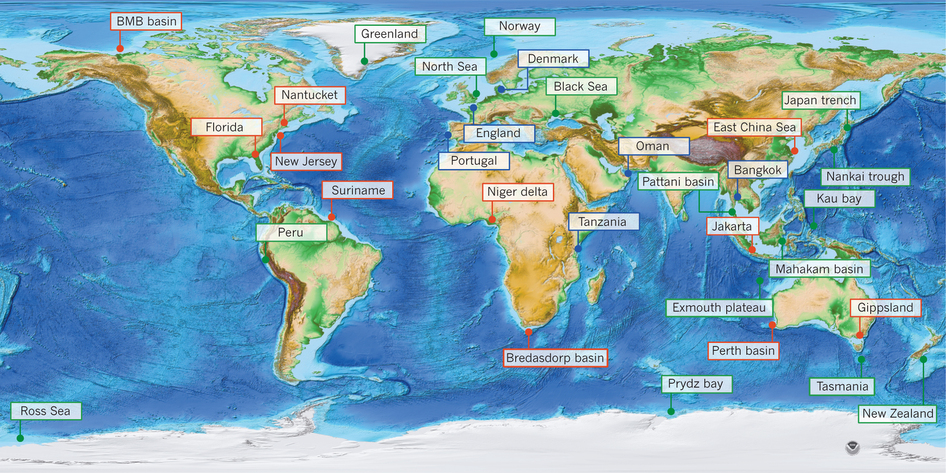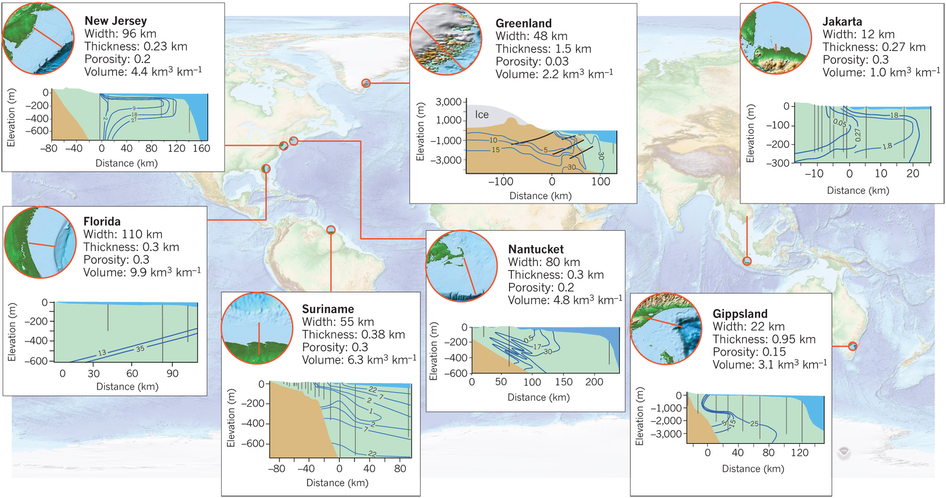BLOG
January 22nd, 2014
Via the International Water Law Project, a commentary on offshore fresh water aquifers:
In recent years, increasingly urgent voices have been warning of a global water crisis, as the human species consistently uses more water than is sustainably available. Pictures of parched lands, disappearing lakes and streams, and single-faucet villages have become commonplace as thirsty straws siphon life-giving water from above and below the surface of the earth. Currently a billion people – 40% of humanity – live in water-stressed conditions, and studies predict that the situation will deteriorate rapidly in the next few years, as the agricultural sector, which already accounts for an average of 70% of global fresh water use, struggles to feed an additional billion by 2030.

Figure 1: World map of topography and bathymetry showing known occurrences of fresh and brackish offshore groundwater.
Reprinted by permission from Macmillan Publishers Ltd: V. Post, et.al., Offshore fresh groundwater reserves as a global phenomenon, Nature, Vol. 504, pp. 71–78 (5 December 2013) doi:10.1038/nature12858Suddenly, in early December, a ray of hope appeared as a group of Australian scientists published a paper in Nature heralding discovery of vast meteoric fresh groundwater reserves off the coasts of China, Australia, North America, Greenland, Suriname, Nigeria and South Africa. The group’s leader, Dr. Vincent Post of the National Centre for Groundwater Research and Training (NCGRT) and the School of the Environment at Flinders University, predicted that the “volume of this water resource is a hundred times greater than the amount we’ve extracted from the Earth’s sub-surface in the past century since 1900,” and went on to say that “[k]nowing about these reserves is great news because this volume of water could sustain some regions for decades.” In spite of a cautionary message in the article that “[o]ffshore groundwater is not the answer to global water crises”, one recent headline excitedly proclaimed, “Aussie Scientists May Have Solved the Global Water Shortage Crisis.”
There are several reasons why the prospect of vast seabed aquifers should not distract us from addressing fresh water shortages. First, the article admits that “[d[espite convincing indications of the widespread presence of offshore paleo-groundwater, direct observations remain limited.” With very few exceptions, the presence of seabed aquifers has not been proven but is based on sporadic sampling and intensive modeling. Technical challenges must be overcome in order to locate and access the aquifers, without introducing contamination that would forever foul the confined waters. Further, the waters are not expected to be fresh, but rather either brackish or somewhat saline, meaning treatment will be required prior to use. Once the quantity and quality of the contained water is determined, it must be abstracted and transported to a treatment or desalination facility that would probably be located on-shore at some distance from the wellhead. Finally, after weighing the benefits and risks, one or more parties must be willing to invest substantial sums to find, recover and treat the water. The investors would be unusually philanthropic if they did not expect an economic return within a reasonable time, so a mechanism for monetizing the water would have to be agreed upon. If we accept Dr. Post’s statement that the seabed aquifers would meet our needs for only a few decades, any “solution” offered by the discovery would be short-lived at current consumption rates.

Figure 2: Global overview of inferred key metrics and cross sections of well-characterised vast meteoric groundwater reserves.
Reprinted by permission from Macmillan Publishers Ltd: V. Post, et.al., Offshore fresh groundwater reserves as a global phenomenon, Nature, Vol. 504, pp. 71–78 (5 December 2013) doi:10.1038/nature12858Assuming, however, that the challenges regarding accessibility and financial return could be overcome, determinations would have to be made whether jurisdiction and ownership of the water would follow domestic law, international water law, or the Law of the Sea. Aquifers lying under the territorial sea of one nation would doubtless be governed by its domestic laws, but questions would arise for transboundary aquifers. If international water law principles were to guide ownership and use, a further determination would have to be made about which guidelines to follow. The Convention on the Law of the Non-navigational Uses of International Watercourses (the Watercourses Convention) needs ratification by two more states to enter into force, but by its terms the Watercourses Convention only applies to aquifers with a link to a surface water system. Since they are fossil aquifers, the seabed aquifers lack such a link to any surface water system. The 2008 UN Draft Articles on the Law of Transboundary Aquifers (the “Draft Aquifer Articles”) include fossil aquifers within their scope, granting nations full sovereignty to aquifer formations and the water therein that lie under their borders (Art. 3). However, the Draft Aquifer Articles have thus far received scant attention, and, in the Case Concerning the Gab?íkovo-Nagymaros Project, the International Court of Justice rejected the notion of absolute sovereignty over transboundary waters. If the treaty void for transboundary aquifers were to be filled by adopting customary laws that have developed for transboundary surface waters, then nations sharing transboundary seabed aquifers may be expected to abide by such customary law principles as equitable and reasonable use, prevention of significant harm and exchange of information.
Alternatively, one could argue that the UN Convention on the Law of Sea (UNCLOS), which has entered into force, should serve as the prevailing set of guidelines. In that case, a preliminary determination would have to be made as to whether water should be treated as a non-living resource such as minerals, oil and gas. Under UNCLOS, non-living resources located within the 200-mile exclusive economic zone (EEZ) of a nation belong to that nation. Oil and gas extraction follows the law of capture, which can result in windfall for nations with access to technology and financial resources. An argument could be made that fresh, or even brackish, water should not be treated as a non-living resource, since water is the most vital of resources, necessary to support terrestrial life. Indeed, the scope of the Draft Aquifers Articles initially included oil and gas along with water, but water was deemed too important to be treated in the same way as other extractive resources (see C. Yamada, Fourth report on shared natural resources: transboundary groundwaters (2007)).
The day may come when technology, financing and need will all converge to make extraction of the water in the seabed aquifers practical and even necessary. Prior to that day, fundamental questions on legal regimes and treatment of vital resources will have to be raised and answered.

